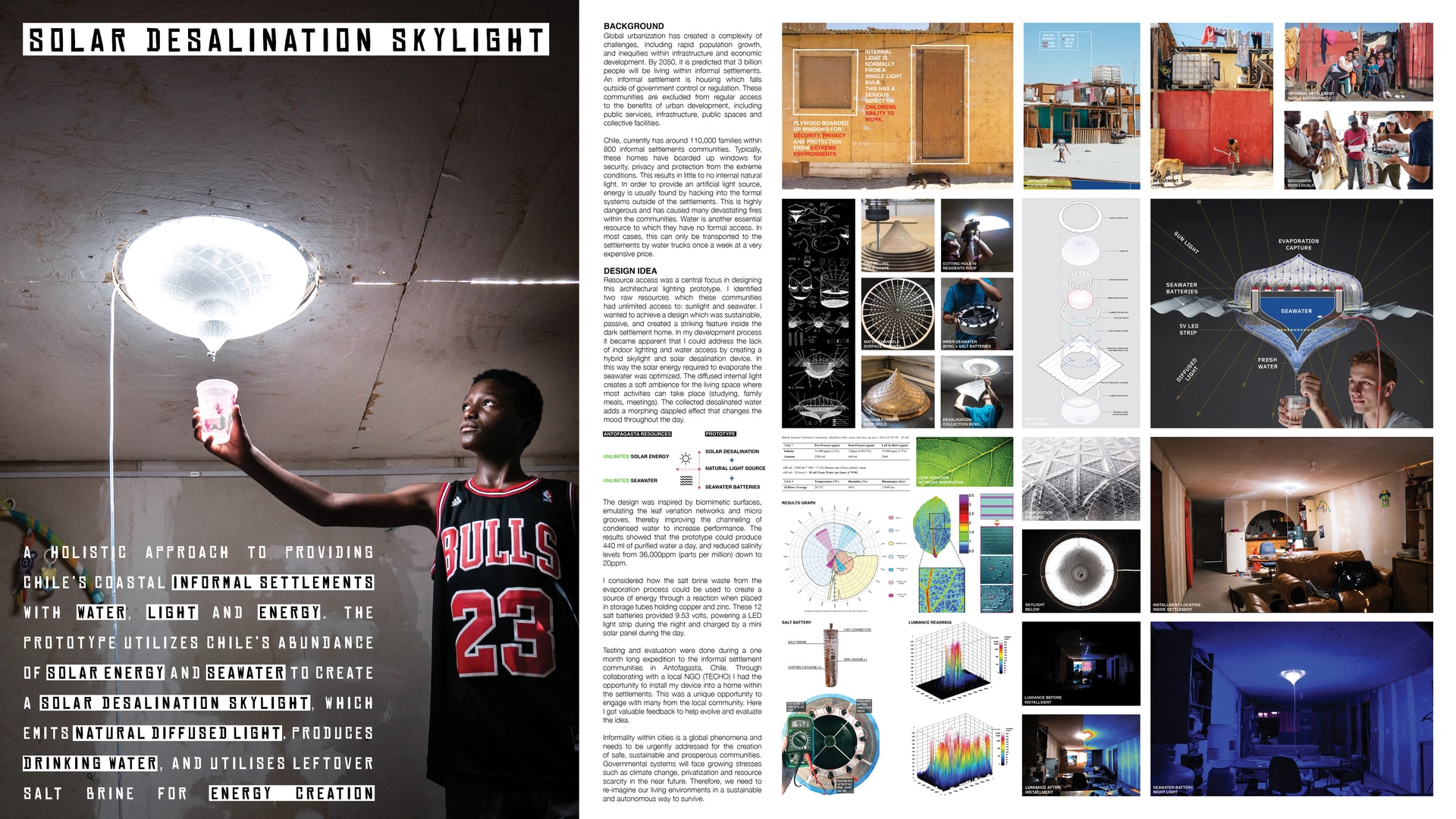Solar Desalination Skylight

Category
Daylight in Buildings
Students
Henry Glogau
Teacher
David Garcia
School
Royal Danish Academy of Fine Arts
Country
Western Europe
Download
Download ↓
‘A holistic approach to providing Chile’s coastal informal settlements with water, light and energy. The prototype utilises Chile’s abundance of solar energy and seawater to create a solar desalination skylight, which emits natural diffused light, produces drinking water, and utilises leftover salt brine for energy creation’ BACKGROUND: Global urbanization has created a complexity of challenges, including rapid population growth, and inequities within the infrastructure and economic development. By 2050, it is predicted that 3 billion people will be living within informal settlements. An informal settlement is housing that falls outside of government control or regulation. These communities are excluded from regular access to the benefits of urban development, including public services, infrastructure, public spaces and collective facilities. Chile, currently has around 110,000 families within 800 informal settlements communities. Typically, these homes have boarded up windows for security, privacy and protection from the extreme conditions. This results in little to no internal natural light. In order to provide an artificial light source, energy is usually found by hacking into the formal systems outside of the settlements. This is highly dangerous and has caused many devastating fires within the communities. Water is another essential resource to which they have no formal access. In most cases, this can only be transported to the settlements by water trucks once a week at a very expensive price. DESIGN IDEA: Resource access was a central focus in designing this architectural lighting prototype. I identified two raw resources which these communities had unlimited access to: sunlight and seawater. I wanted to achieve a design which was sustainable, passive, and created a striking feature inside the dark settlement home. In my development process it became apparent that I could address the lack of indoor lighting and water access by creating a hybrid skylight and solar desalination device. In this way the solar energy required to evaporate the seawater was optimized. The diffused internal light creates a soft ambience for the living space where most activities can take place (studying, family meals, meetings). The collected desalinated water adds a morphing dappled effect that changes the mood throughout the day. The design was inspired by biomimetic surfaces, emulating the leaf venation networks and micro grooves, thereby improving the channeling of condensed water to increase performance. The results showed that the prototype could produce 440 ml of purified water a day, and reduced salinity levels from 36,000ppm (parts per million) down to 20ppm. I considered how the salt brine waste from the evaporation process could be used to create a source of energy through a reaction when placed in storage tubes holding copper and zinc. These 12 salt batteries provided 9.53 volts, powering a LED light strip during the night and charged by a mini solar panel during the day. Testing and evaluation were done during a one month long expedition to the informal settlement communities in Antofagasta, Chile. Through collaborating with a local NGO (TECHO) I had the opportunity to install my device into a home within the settlements. This was a unique opportunity to engage with many from the local community. Here I got valuable feedback to help evolve and evaluate the idea. Informality within cities is a global phenomena and needs to be urgently addressed for the creation of safe, sustainable and prosperous communities. Governmental systems will face growing stresses such as climate change, privatization and resource scarcity in the near future. Therefore, we need to re-imagine our living environments in a sustainable and autonomous way to survive.

























